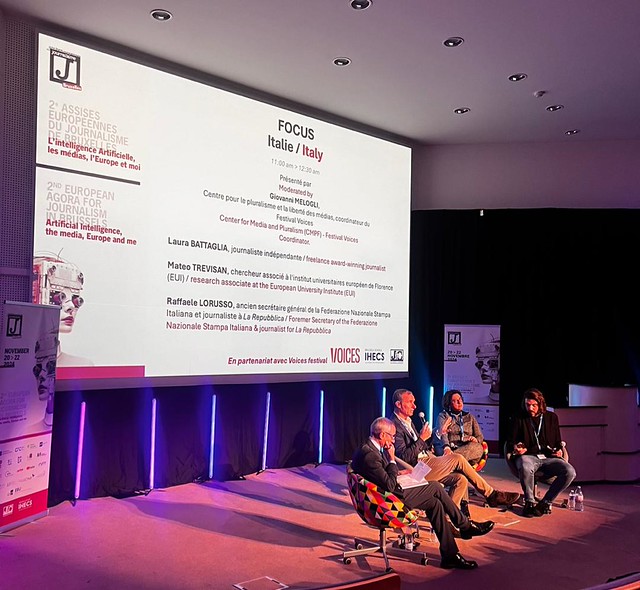With Laura BATTAGLIA, freelance award-winning journalist, Matteo TREVISAN, research associate at the Center for Media Pluralism and Media Freedom, Raffaele LARUSSO, general Secretary of the Federazione Nazionale Stampa Italiana and journalist for La Republica.
In partnership with the Voices Festival and moderated by Giovanni MELOGLI, Center for Media and Pluralism (CMPF) – Festival Voices Coordinator.
Key issue
Media experts say Italy is not improving as fast compared to other European Union countries. The 2024 RSF ranking puts Italy in the middle (51%) – a level of medium risk. To evaluate the evolution of the position of the media and the freedom of speech in Italy, the Media Pluralism Monitor (MPM) is the method used. This round table aims at understanding the sources of risk by indicators.
What they said:
Matteo TREVISAN, research associate at the Center for Media Pluralism and Media Freedom: “The market plurality area (61% , Medium risk) has as main sources of risk, due to the limitation of transparency of media ownership which has led to limited effectiveness. Also the high degree of concentration of the media market in digital media […] is difficult to assess due to lack of data.”
“Political independence sit at 52% (Medium risk). The main sources of risk are the reform on conflict of interests is pending, and the indirect ownership control […]. The National Collective Labour Agreement has not been renewed yet plus the current version has no safeguards against politicised appointments and dismissals of editors-in-chief.”
“Social inclusiveness has returned an average ranking (54%). It can be perceived in gender equality in the media: serious imbalance against women in the governance of editorial companies, at the top of editorial offices, and in the participation in political, informative programmes and articles.”
Laura BATTAGLIA, freelance award-winning journalist: “There are three main issues: firstly, isolation of the [Italian] language; secondly, the business model [is] based on the past, that doesn’t take into consideration the digital media landscape; thirdly, unions, while doing a great job, are blocking part of the develpment of the industry – they create two levels inside the mediae landscape.”
Raffaele LARUSSO, general Secretary of the Federazione Nazionale Stampa Italiana and journalist for La Républica: “The press in Italy is free, but we often have problems with freedom of journalists. They may be victim of personal attacks, of tricks or judiciary actions.”
“Politics will always try to fight against the work of the journalists. The shield will always be the constitution.”
“We have a problem with a law issued in 2014 that gives the government to choose the management of the public broadcasting service (PBS) – it is not online with the media freedom act. Italy has to change that law.”
Takeaways
The Italian media landscape must be able to renew itself. Both in terms of human resources and digital literacy. There is a need to adapt a new model of media business, that can be beneficial to new and past generations who consume media products differently. Finally, the bad marriage between politicians and journalists calls on the stability of the constitution as time goes on.
Christèle Avom (EPJT)
